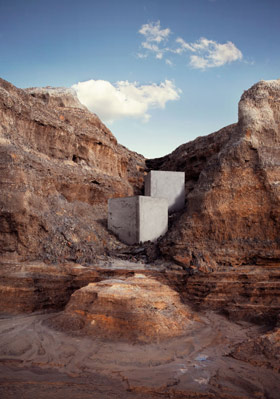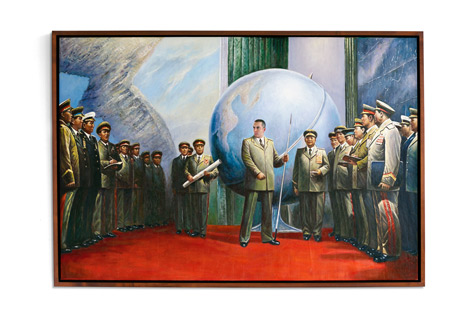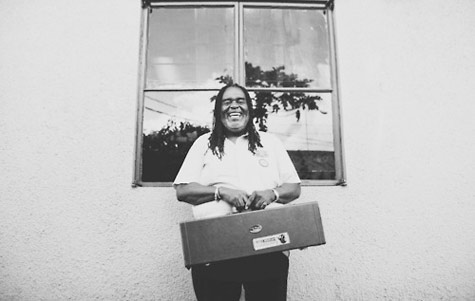
Young, hungry, talented and delightful, friend of aCurator
Abby Ross was at Tuff Gong Studios in Kingston, Jamaica, recently and pulled off some gorgeous portraits including musicians who played with Bob Marley.
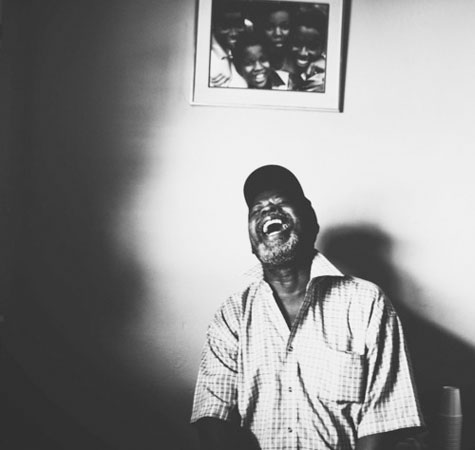


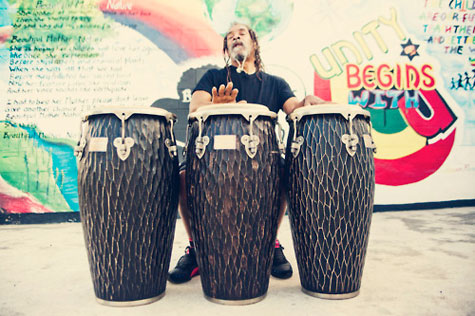 Top to bottom:
Top to bottom:
Dean Fraser, Horns
Bo Pee, Guitarist
Squidly Cole, Drummer
Uzziah "Sticky" Thompson, Percussionist
Larry MacDonald, PercussionistAll images © Abby Ross
Mark Dorf is based in Savannah, Georgia. I'm thrilled this young photographer has his submission skills down pat, and whilst still in school, is surely getting his work out there. Please enjoy his artist statement and thought-provoking imagery.
"Our current landscape is one that is permeated with man made monoliths, sitting on the horizon, reforming the clean line that was once firmly established. The creation of this ever-expanding human footprint encroaches carelessly upon our environment without control at every moment. Creation can be considered one of the most powerful abilities a human possesses, whether it be through the hand of an artist, the architect or businessman, an inherent amount of power and control is given to the creator. However, this amount of control and power can grow to become intoxicating leading to devastating adverse and unseen side effects. However apparent these effects are, they are not always understood and can be ignored and seen as neutral to those who encounter them until it is too late and the potential damage has been done.
Environmental Occupations explores humanity's role of creation and its relationship with its environment. The concrete forms seen in the images, influenced by minimalist sculptors such as Donald Judd and Richard Serra, downplay any sort of expression and instead reference nothing but geometry and the dense substance that they are made from. The aggressive shape, material, and imposing presence of the objects contrast greatly against the natural and spiritual landscapes in which they are found, rendering them out of context and providing a skewed image from what is inherently reality. The question arises, where did these forms originate? Was there a creator? What are these things?
Though these forms seem to mimic functional urban horizons, they themselves are useless and loom in the landscape with a quiet devastation. The forms look to have been man made, but their sheer size and lack of evidence of construction leave the viewer with a disconnect between a specific creator and the objects - just as we see in our mass produced urban world today. The figures within the images speak to the various roles found in the process of creation, ranging from the originator to the mindless and passive observer, impotent and unaware of his or her surroundings."
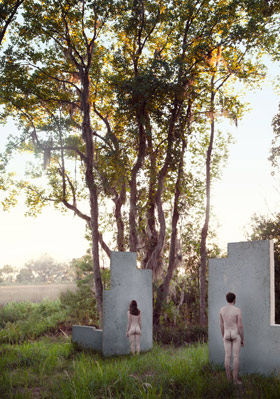 "Sovereignty"
"Sovereignty"

At the Karsh Estate, we get word from various people when they find something of interest on the web. The curator at the Supreme Court was doing research and came across an article from
Popular Science Magazine from 1952, which talks about Karsh and his techniques, his equipment, and his recent "branching out" into industrial work. It is noted that "...because he is fascinated by the human countenance his pictures of factory interiors have workmen's faces in the foreground."
Ford of Canada 'Rear Window', Gow Crapper, 1950 © Yousuf Karsh Mikael Kennedy
Mikael Kennedy told me he spent the first dozen or so years of his life convinced he was going to die, and that when he didn't, he began seeing the world differently, wanting to experience everything he could. These photographs are a sampling from the results of Mikael's recent years of domestic and international "wandering around" with his Polaroid camera: couch surfing; sleeping on beaches, in vans; nomadic. Ambivalent at first about a feature, unsure about the format, the photographs have grown on me. I've found myself daydreaming, enjoying a vicarious moment.
Mikael has a new limited edition book available for pre-order, 7 in his series 'Passport To Trespass'. More info
here ; heads-up - all volumes sold out, with volume 6 going in four weeks. Hunt them Out' is a limited edition booklet printed in conjunction with the release of these 20 Polaroids for sale through a special online exhibition of the prints available only through
Peter Hay Halpert Fine Art Gallery in NYC.
Read the back story on Mikael's wanderings.
View the full screen magazine photo feature. 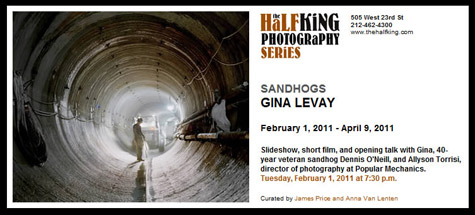
Photography's new year is well under way and on February 1st the Half King will host a special evening to launch
Gina LeVay's Sandhogs exhibition. Gina will be speaking, and joining her will be a real live Sandhog, Dennis O'Neill. Come to West Chelsea for a beer and short film.
Meanwhile, take a look at
Gina's feature in aCurator Magazine to learn more about how she shot this amazing series.
It can only be a good day when Phil Toledano announces a new body of work and on a cold grey one it's warming to see his latest:
Kim Jong Phil.
Quoth he: "I think a great deal about what it means to be an artist."
"I reflect on the elaborate psychological mechanisms required to pursue something so elusive, so ambiguous. I often wonder: 'Am I talking to myself?'
I don't make work for other people, but as an artist, I need to be in dialogue with the world that exists beyond my overpopulated cranium. I've concluded that to be effective-to be functional-I must guzzle an eye-popping cocktail of delusion and narcissism.
It occurred to me that being an artist is a great deal like being a dictator.
Just like a dictator, I must live in a closed loop of self-delusion. A place where my words and ideas always ring true. A gilded daydream of grandiosity. There can be no room for doubt. I must be convinced that I have something vital to say. I must believe that the world is waiting in keen anticipation to hear my message.
For my palette, I've copied pre-existing dictatorial art. Paintings from North Korea, statues of assorted dictators (Kim Il Sung, Laurent Kabilla, and Saddam Hussein). I had these works re-created in China, and each instance, I've replaced the great leaders with myself."
Bloody brilliant. Read a thoroughly excellent interview with Mr Toledano via
APhotoEditor.
Mr Toledano as Laurent Kabila, 20 inches.
International world global domination. Oil on canvas, 40x50 inches © Mr Toledano
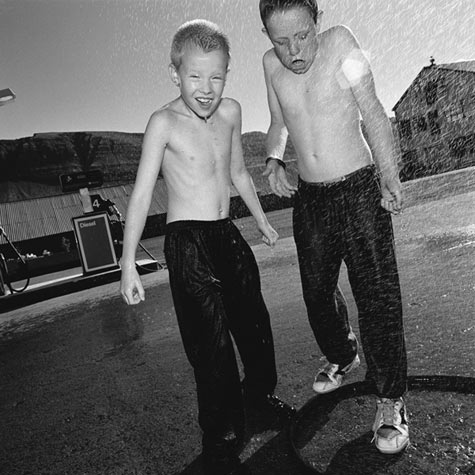 From Shipping Forecast: South-East Iceland, Saturday 10 August 1996 © Mark Power
From Shipping Forecast: South-East Iceland, Saturday 10 August 1996 © Mark Power
Amador Gallery will be opening an exhibition of one of my personal faves,
Mark Power, on January 26th 2011 at their midtown location. I'm most familiar with Power's 'Shipping Forecast' series, alongside which will be a new body of work, 'The Sound of Two Songs'.
"The Sound of Two Songs is the result of the artist's love affair with Poland, describing in photographic terms the changing social values of a country caught between the past, the present and the future, both in terms of attitude and of the contradictions found in its landscape. The series reflects both the urban and the rural, the old and the new, setting the crumbling inner city housing estates of the Communist era against the new developments of colorful apartments and gleaming shopping centers."
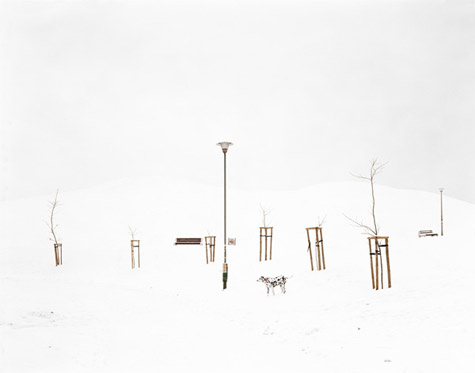 From The Sound of Two Songs, Warsaw, February 2005 © Mark Power
From The Sound of Two Songs, Warsaw, February 2005 © Mark Power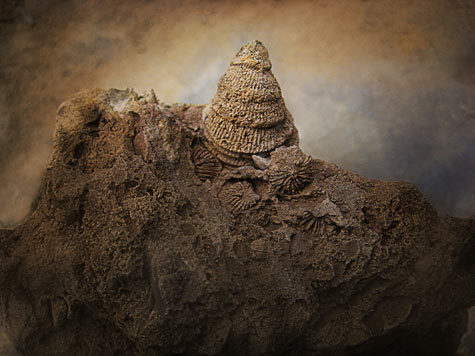
This arresting feature was guest curated by Louisa Curtis of
Chatterbox Enterprises.
"I met photographer
Art Murphy a few years ago when he was also working as an accomplished retoucher and printer in New York. Fast-forward a few years, add in a life-changing move from the city to the Catskills, and an already-existing interest in things past, and we have a new fine art project, inspired by nature, studying 380 million year-old fossils that are found in abundance around his home. Art has created an exquisite body of work that one minute transports us into feeling we are truly underwater, exploring for hidden treasures at the bottom of the inland sea, and then another that might remind us of ancient life forms, marine invertebrates that existed all those years ago. The images have a softness and subtlety of color that seem unlikely for such crusty remnants of old age. They are, quite simply, beautiful. Last year, prompted by an exhibition opportunity, Art's work was presented as a one-of-a-kind art book in the style of an old Catskills scrapbook, where a link was examined between the painters of the Hudson River School of Art and the earliest geologists who explored the country. To see more about the project, the book and the images, please visit his
website." - Louisa Curtis
"My images are an attempt to focus on the intrinsic beauty of these
early life forms and provide the viewer with a more visceral and
emotional interaction - a connection between the distant past and the
present, what is buried all around us as part of the evolutionary trail
of life here in the Hudson Valley. As I see it, this work tends to
bridge a gap between art and science. The visual manifestations of
science and nature contain an often-overlooked wealth of aesthetic
experience. I have the good fortune of living in a most beautiful area,
tucked in the woods between the Hudson River and the eastern edge of the
Catskills. Thanks to its unique geologic history, fossils abound,
specifically invertebrate fossils from the
Devonian Period.
In many locations it sometimes seems that every other rock contains a
fossil. They can appear to be so commonplace that, aside from
schoolchildren hunting for them on science field trips, most of us
stumble over them with barely a notice. Not long ago, I took the time to
look a bit closer and was amazed at what I found. The images that
appear here are part of a long-term project, a decidedly unscientific
one that reflects the intrinsic beauty of these creatures from an
incomprehensibly distant past. In removing any reference to suggest
scale, they appear as beautiful sculptural objects seeming to grow out
of the surrounding rock.
I have often said that, while the Hudson River painters hiked the area they carried hammer, chisel, and sketch book, I carry hammer, chisel, and digital camera. I shoot while out in the field, particularly when I find something too big to carry back to the studio. Most often, though, I carry bags full of rocks home. Some of the fossils are free-standing. Most are buried in rock. Once you become familiar, you can tell that certain rocks will have greater or lesser possibility of containing fossils. I carefully begin cracking them open and then the fun begins. Cracks in the rocks will often lead to well defined fossils and then I explore the patterns and designs that emerge with the camera. Sometimes a single large rock can have me busy for days." - Art Murphy
Thanks to Louisa for her work on this story.
View the full screen magazine photo feature.
Fossil © Art Murphy
Simone Rosenbauer is one of the selected artists for
reGeneration² and she attended the panel discussion at
Aperture last night. A young German living in Australia, she told me about her project '
Small Museum'. She's been to 40, and there are more. Bloody brilliant. More projects on her
website.

I have worked with the Estate of Yousuf Karsh for several years, and I edited text for the official
Yousuf Karsh website, but I still hear stories about the shoots that I have never heard before. Tooling around today I found a comment from 2009 in an article on
The Online Photographer, Mike Johnston's extensive photo blog, about Karsh's most recent book '
Regarding Heroes', from a reader who had attended the opening at the Art Institute of Chicago. Director and Curator for the Estate, Jerry Fielder, had related the story of Karsh's 1990 session with Mandela, and confirms this is what happened.
I personally never had the opportunity to meet Mr Karsh but it's easy to gather he was extremely charming and entertaining. The commenter,
Ken Tanaka, put it so well, I hope he doesn't mind me lifting his comment.
"In 1990 Karsh was to photograph Nelson Mandela. Mandela arrived at Karsh's studio in Ottawa with only an hour of rest after his long trip from South Africa. Karsh was normally a master of establishing quick rapport with his sitters but he could see that Mandela was just plain exhasuted and that getting that "public mask" off would be very hard at that moment.
So Karsh decided to try telling Mandela a story to warm things up. He recounted a recent session in which he photographed the Pope. While chatting, he asked him, "How many people work at the Vatican?". The Pope considered the question for a moment, as if trying to formulate an accurate answer, and then replied, "About half.". For a moment Mandela's exhaustion and troubles lifted as he found the little story hilarious. Click! Karsh managed to capture that moment in this portrait."
This is one of the results.








